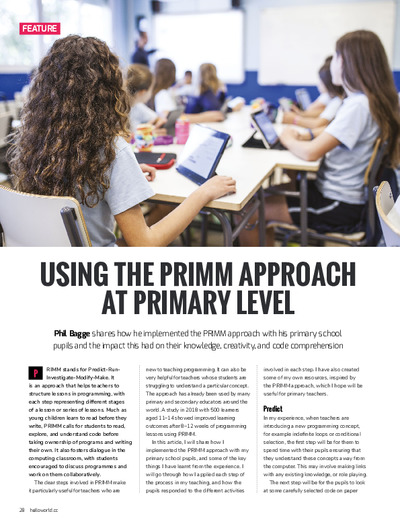Using the PRIMM Approach at Primary LevelPhil Bagge
|
 |
 Diese Seite wurde seit 3 Jahren inhaltlich nicht mehr aktualisiert.
Unter Umständen ist sie nicht mehr aktuell.
Diese Seite wurde seit 3 Jahren inhaltlich nicht mehr aktualisiert.
Unter Umständen ist sie nicht mehr aktuell.
 Zusammenfassungen
Zusammenfassungen
 In this article, I will share how I
implemented the PRIMM approach with my
primary school pupils, and some of the key
things I have learnt from the experience. I
will go through how I applied each step of
the process in my teaching, and how the
pupils responded to the different activities
FEATURE
involved in each step. I have also created
some of my own resources, inspired by
the PRIMM approach, which I hope will be
useful for primary teachers.
In this article, I will share how I
implemented the PRIMM approach with my
primary school pupils, and some of the key
things I have learnt from the experience. I
will go through how I applied each step of
the process in my teaching, and how the
pupils responded to the different activities
FEATURE
involved in each step. I have also created
some of my own resources, inspired by
the PRIMM approach, which I hope will be
useful for primary teachers. PRIMM stands for Predict-Run-
Investigate-Modify-Make. It
is an approach that helps teachers to
structure lessons in programming, with
each step representing different stages
of a lesson or series of lessons. Much as
young children learn to read before they
write, PRIMM calls for students to read,
explore, and understand code before
taking ownership of programs and writing
their own. It also fosters dialogue in the
computing classroom, with students
encouraged to discuss programmes and
work on them collaboratively.
PRIMM stands for Predict-Run-
Investigate-Modify-Make. It
is an approach that helps teachers to
structure lessons in programming, with
each step representing different stages
of a lesson or series of lessons. Much as
young children learn to read before they
write, PRIMM calls for students to read,
explore, and understand code before
taking ownership of programs and writing
their own. It also fosters dialogue in the
computing classroom, with students
encouraged to discuss programmes and
work on them collaboratively. Dieser Zeitschriftenartikel erwähnt ...
Dieser Zeitschriftenartikel erwähnt ...
 Dieser Zeitschriftenartikel erwähnt vermutlich nicht ...
Dieser Zeitschriftenartikel erwähnt vermutlich nicht ... 
 Nicht erwähnte Begriffe | Bildung, Digitalisierung, Eltern, Lernen, Schweiz, Unterricht |
 Tagcloud
Tagcloud
 Volltext dieses Dokuments
Volltext dieses Dokuments
 Anderswo suchen
Anderswo suchen 
 Beat und dieser Zeitschriftenartikel
Beat und dieser Zeitschriftenartikel
 Beat hat Dieser Zeitschriftenartikel während seiner Zeit am Institut für Medien und Schule (IMS) ins Biblionetz aufgenommen. Beat besitzt kein physisches, aber ein digitales Exemplar. (das er aber aus Urheberrechtsgründen nicht einfach weitergeben darf). Aufgrund der wenigen Einträge im Biblionetz scheint er es nicht wirklich gelesen zu haben. Es gibt bisher auch nur wenige Objekte im Biblionetz, die dieses Werk zitieren. Beat selbst sagt, er habe dieses Dokument überflogen.
Beat hat Dieser Zeitschriftenartikel während seiner Zeit am Institut für Medien und Schule (IMS) ins Biblionetz aufgenommen. Beat besitzt kein physisches, aber ein digitales Exemplar. (das er aber aus Urheberrechtsgründen nicht einfach weitergeben darf). Aufgrund der wenigen Einträge im Biblionetz scheint er es nicht wirklich gelesen zu haben. Es gibt bisher auch nur wenige Objekte im Biblionetz, die dieses Werk zitieren. Beat selbst sagt, er habe dieses Dokument überflogen.











 Kinder
Kinder LehrerIn
LehrerIn Primarschule (1-6) / Grundschule (1-4)
Primarschule (1-6) / Grundschule (1-4) Programmieren
Programmieren Schule
Schule , 642 kByte)
, 642 kByte)  Biblionetz-History
Biblionetz-History